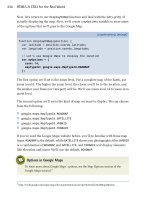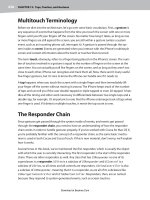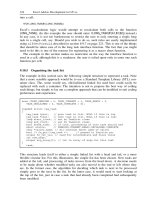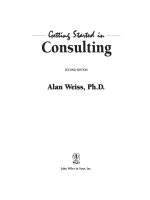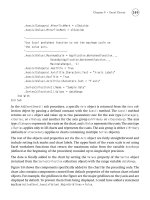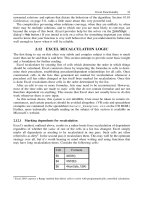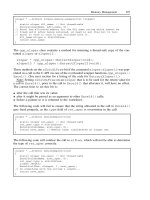Financial Applications Using Excel Add-in Development in C/C++Second Edition phần 9 pot
Bạn đang xem bản rút gọn của tài liệu. Xem và tải ngay bản đầy đủ của tài liệu tại đây (244.38 KB, 58 trang )
Miscellaneous Topics 439
}
if(m_Vol <= 0.0)
return false;
double d1 = log(m_Fwd / m_Strike) / m_vRootT + m_vRootT / 2.0;
double N1 = ndist(d1); // ndist(x) = N(x)
double N2 = ndist(d1 - m_vRootT);
m_Call = m_Fwd * N1 - m_Strike * N2;
m_Put = m_Call + m_Intrinsic;
m_Straddle = m_Call + m_Put;
if(!calc_derivs)
return true;
// Hedge calculations assume constant volatility
double n1 = n(d1); // n = dN(x)/dx
m_PutDelta = (m_CallDelta = N1) - 1.0;
m_Gamma = n1 / m_vRootT / m_Fwd / m_Vol;
m_Vega = n1 * m_vRootT * m_Fwd;
return true;
}
The following XLL-exportable function shows a simple example of its use. It is also used
in the example implementation of CMS derivative pricing (see section 10.11 on page
513).
xloper * __stdcall BlackOpt(double t_exp, double fwd, double strike,
double vol)
{
BlackOption Opt(t_exp, fwd, strike, vol);
Opt.Calc(true); // true: calc greeks
#define NUM_BLACK_RTN_VALS 6
double ret_vals[NUM_BLACK_RTN_VALS] = {
Opt.GetCallPrice(), Opt.GetPutPrice(),
Opt.GetCallDelta(), Opt.GetPutDelta(),
Opt.GetGamma(), Opt.GetVega()};
// Return a single row array
cpp_xloper RetVal((RW)1, (COL)NUM_BLACK_RTN_VALS, ret_vals);
return RetVal.ExtractXloper();
}
C++ class construction iteratively (and implicitly) calls the constructor of any contained
class. Consider the following example:
class A
{
public:
A() {m_iVal = 0;}
A(int i) {m_iVal = i;}
void SetVal(int i) {m_iVal = i;}
int GetVal(void) const {return m_iVal;}
440 Excel Add-in Development in C/C++
private:
int m_iVal;
};
class B
{
public:
B(int i) {m_Ainstance.SetVal(i);}
int GetVal(void) const {return m_Ainstance.GetVal();}
private:
A m_Ainstance;
};
class C
{
public:
C(int i) : m_Ainstance(i) {}
int GetVal(void) const {return m_Ainstance.GetVal();}
private:
A m_Ainstance;
};
When an instance of class B is created, the contained instance of class A’s member
variable
m_iVal is first initialised to zero in an implicit call to A’s default constructor,
and then is reset with an explicit call to
SetVal(). In class C, on the other hand, A’s
second constructor is called explicitly and
m_iVal is set only once. This is a trivial
example of something that experienced C++ programmers will be well aware of, but with
more complex objects such things can have a significant impact on performance.
Also on the subject of minimising constructor and destructor calls, classes should always
be passed and returned by reference (or by pointer). Passing or returning by value causes
the implicit creation, copying and destruction of temporary class instances.
You should also avoid calling into Excel through the C API for functions that are also
available in standard string or mathematics libraries, for example. This is because the
overhead of calling into Excel is significant. You can break this rule where you are not
calling back into Excel very often, or where you need compatible behaviour with the
worksheet functions.
There are many other ways in which code can leak performance, such as the inefficient
use of arrays, for example. These are too numerous to go into in great detail, suffice to
say that there is still good reason to write nice code.
9.14.2 VBA code optimisation
Given that VBA is much slower than compiled C++, it is likely that at some point you
will find there is a performance bottleneck in your VBA code. The highly-recommended
Professional Excel Development
10
contains a chapter specifically about the optimisation of
VBA. The following list reproduces some of the optimisations they recommend, although
there is a great deal more said in their text.
10
Bullen, Bovey and Green, 2005, Addisson Wesley.
Miscellaneous Topics 441
• Use matching data types to avoid implicit conversions, and use Variants only where
necessary.
• Perform explicit type conversions
CStr(), CDbl(), etc., instead of VBA’s implicit
conversions.
• Use
Len(string)= 0 instead of string= "" to detect zero length/empty strings.
• Use string-typed string functions instead of Variant functions, e.g., use
Left() instead
of
Left().
• Pass strings and arrays
ByRef instead of ByVal.
• Use
Option Compare Text to make string comparisons case-sensitive by default,
using the
CompareMethod of StrComp() when case-insensitivity is needed.
• Avoid late binding by declaring object variables as their explicit types instead of
As
Object
.
• Use integer division instead of floating point division (\ instead of /) where integer
arguments are being evaluated to an integer.
• Iterate collections using
For Each instead of For Next and indexing.
• Iterate arrays using
For Next and indexing instead of For Each.
• Use
If bVariable Then instead of If bVariable = True Then
• Use
If Then ElseIf Then instead of IIF() or Select Case
• Use With End With blocks wherever possible.
There may be times when you feel the readability of your code is improved with one of
the less-efficient ways of doing things.
Select Case for example leads to very readable
maintainable code, so you might justifiably prefer it.
9.14.3 Excel calculation optimisation
Optimising the calculation time of an Excel spreadsheet is a far more complex topic than
the code optimisations discussed briefly above. There are many more factors that can
affect the perceived amount of time spent in recalculation:
• System resource availability and performance (memory, processor, disk and network
access time, multi-threading settings in Excel 2007, etc.)
• Workbook complexity (inter-workbook and inter-worksheet links, number of cells con-
taining formulae, display complexity, etc.)
• Worksheet formula choices (use of volatile functions, use of inefficient functions)
• XLL add-in and user-defined function performance
• VBA user-defined function performance
• COM add-in function performance
Understanding the first point, resource availability, is key to knowing how much effort
to put into resolving the others. A system that’s low on memory or that makes frequent
access to a remote system via a slow network connection, or a remote system that is
struggling to keep up, will not be helped much by increasing the speed of execution of an
add-in function. Equally, where a simple and cheap upgrade of hardware will restore the
recalculation time expected by the user, relatively costly development hours are probably
better not spent on optimisation. With Excel 2007, the purchase of a second processor or
a dual-core machine could reduce calculation times by up to half.
442 Excel Add-in Development in C/C++
Multi-threading in Excel 2007 can also improve performance on a single processor
machine where a UDF makes a call to a remote calculation server (or server farm or
cluster) where the server has many processors. This enables the single processor machine
to send many requests off to the server roughly at the same time, fully loading the server,
rather than having to wait for each calculation request to complete before sending the next.
Even given the often better alternatives to re-coding, you would hope not to end up in
a situation where you have to perform emergency optimisation on your workbooks and
projects. Following sound principles from the outset, performance should only deteriorate
slowly as new features/code/cells are added. However, there are times when things can
get a little sluggish and the rest of this section aims to provide some practical advice on
what to do.
Many of the previous chapters and sections of this book refer to performance. In fact,
given that the use of XLLs is largely a performance-driven choice, you could say that
this entire book is about improving performance. So rather than restating all that has been
said already, this section refers back to those sections and adds additional advice where
necessary. There is one important point that applies to all programming optimisation, and
that is to avoid, or at least be aware of, implicit type conversions. When designing the
interfaces for your XLL worksheet function exports, and you need to get best possible
performance, it is better to register all of your arguments as value
xloper/xloper12s
(type P/Q) as this avoids the overhead of Excel conversion. You do, of course, then need
to check that the types in your code are correct, and convert them or fail, depending on
how exacting you are with the caller.
Before getting to that, there is some ancient Excel-lore that states that you should
try to arrange your calculations on the sheet such that dependencies run from top-
left to bottom-right. For example,
B2 depending on A1 is good; vice versa is bad.
Whilst this might have been good advice in some past version of Excel (or perhaps some
other spreadsheet package) the author can find nothing to suggest this will
improve performance. The two workbooks
TopLeftDrivenCalcTest.xls and
BottomRightDrivenCalcTest.xls contain named ranges of 50,000 cells, contain-
ing volatile formulae, that are recalculated 1,000 times under VBA macro control. As you
can verify for yourself, the recalculation times are as good as identical.
Section 2.12 Excel recalculation logic, page 33, covers the differences between the
way Excel 97 and 2000 differ from versions 2002+ with respect to the recalculation of
inter-worksheet (not inter-workbook) links. If you or your users are or might be using
97 or 2000 you should be aware of the recalculation problems that careless use of such
links can cause and follow the advice in that section. The section also covers the use and
mis-use of volatile functions, another potential performance black hole, as well as data
tables, where completion of recalculations may not always be obvious, as well as being
slow.
Section 2.16 Good spreadsheet design and practice, page 49, covers some basic ideas
relating to the choice of worksheet function that you make. In particular it discusses
formula repetition and using
MATCH() and INDEX() instead of VLOOKUP().Thereare
myriad examples that could be thought up of two or more ways to use Excel’s own
functions to do the same thing, for example:
=IF(INT(A1)= 1,C1,IF(INT(A1)= 2,C2,IF(INT(A1)= 3,C3,# VALUE!)))
=CHOOSE(A1,C1,C2,C3)
=INDEX(C1:C3,A1)
Miscellaneous Topics 443
These 3 expressions all do almost the same thing. (The third will return a #REF!
error if A1¿3 and INDEX(C1:C3,1.999999761466)will round up to 2 and return C2, whereas
1.999999761465 will round down). Clearly, without some good reason for choosing the
first, the second and third are far more succinct, readable and efficient. It is amazing
that people struggle with the limitation of the number of nested
IF()s that Excel allows
([v11–]: 7, [v12+]: 64) and the ingenious work-arounds, such as splitting more nested
IF()s across more than one cell. If you need more than 3 or 4 in a single expression you
should certainly be considering something like
CHOOSE or INDEX instead, for reasons of
readability, if not performance.
Much of the skill of knowing which combination of Excel’s own functions to best use
can only come with experience, although the general advice is that keeping things simple
and readable will automatically keep them efficient in most cases. This is explained further
in section 2.12.8 on page 41, which covers argument evaluation in functions that condi-
tionally ignore some of their arguments, for example, the functions
IF(), OR(), AND() and
CHOOSE(): All arguments are recalculated prior to Excel calling the function, regardless
of whether or not the result will be ignored. This clearly has an impact on recalculation
time and the section’s advice of using only simple arguments, even if that means refer-
ences to cells containing complex expressions, should always be followed. This is even
true to the extent that an expression like
=B5*IF(C6,1,±1) is slightly more efficient than
=IF(C6,B5,±B5), since in the first example B5 is only dereferenced once.
Once you are happy that any sluggishness cannot easily be removed by optimising
add-in code (after all, you may only have Excel formulae in your workbook), and you
have scoured the workbook for inefficient formulae, you must turn to fine-tuning what
Excel does and does not calculate. In a large workbook, you may have sheets that do not
need to be calculated when the sheet is not being viewed. In other words you may want
to turn off a sheet’s calculation unless it is active. This can make a huge difference to a
large workbook, and fortunately there are a couple of ways to achieve this. An example
of such a sheet might be one that shows a detailed breakdown of something that you
ordinarily do not need to see, or that calculates and displays data graphically.
The
Excel.Worksheet object exposes a property EnableCalculation whose default
state is
True and can be switched off in a VBA macro or with a call via COM. The most
straightforward approach is to place a couple of event traps in the worksheet’s VBA code
module, as shown here:
Private Sub Worksheet_Activate()
EnableCalculation = True
End Sub
Private Sub Worksheet_Deactivate()
EnableCalculation = False
End Sub
This will have the effect of stopping calculation except when active. On activation, the
setting of the property from
False to True triggers Excel to recalculate the sheet, so
that, from the user’s point of view, data will always seem up-to-date (once recalculation
is complete).
The following event will cause the sheet to be updated once only when it becomes
active, but then to be static. There may not be many times when you can get away with
this or need to do it, however.
444 Excel Add-in Development in C/C++
Private Sub Worksheet_Activate()
EnableCalculation = True
EnableCalculation = false
End Sub
Given that you can do these things, you should be designing your workbook to maximise
the number of sheets that you can do this with. This means sketching out the function
of each sheet, the dependencies, and the drivers of calculations. For example, suppose
you want to create a simple workbook that pulls in real-time market data and prices a
small portfolio of derivatives. A sensible hierarchy of worksheets might look something
like this:
Worksheet Notes
Config EnableCalculation: always true
Processes configuration data that is used when building curves, pricing
positions, etc. Calculations are driven by changes to configuration data and a
master non-volatile trigger (could be today’s date).
Curves EnableCalculation: always true
Contains all links to external dynamic real-time data. Processes data for use in
pricing, and increments triggers for dependent calculations.
Portfolio EnableCalculation: true when active only, or always true (see note)
Calculates present value of position in the portfolio using configuration data
from Config and market data from Curves.
Note: Provided other sheets that need real-time updates do not link to this
sheet, this can be recalculated when active only.
Risk EnableCalculation: true when active only
Calculates portfolio risk and display graphs. Depends on volatile curve data
and non-volatile data from Portfolio sheet, i.e., does not depend on Portfolio
being recalculated when curves change.
xCashflow EnableCalculation: true when active only
Calculate and display actual and anticipated cashflows.
Note that xCashflow is so named to ensure that it is after Config and Curves alphabetically,
for the benefit of those running the workbook in versions 97 and 2000.
You may need to go one step further, and be more selective in what you let be recal-
culated on a given sheet. For example, you may have some cells that drive calculations
in other sheets, but other related cells that take a long time to recalculate but do not
drive such things. In this case you would ideally like to be able to tell a function to
recalculate only when it is on the active sheet. As such functions are likely to be either
Miscellaneous Topics 445
VBA user-defined functions or XLL functions, the question is then how can a function
determine this.
In both these cases the trick is to find out where the function is being called from: is
it a worksheet cell or range of cells; are they on the active sheet; and so on. In VBA
this is done using
Application.Caller. This example returns an incremented counter
if called from the active sheet and returns zero otherwise:
Option Explicit
Dim count As Integer
Function CallerIsActive() As Boolean
Dim r As Range
With Application
If IsObject(.Caller) Then
Set r = .Caller
CallerIsActive = (r.Worksheet.Index = ActiveSheet.Index)
Set r = Nothing
Exit Function
End If
End With
CallerIsActive = False
End Function
Function ExampleActiveOnly(trigger As Integer) As Variant
If CallerIsActive() Then
count = count + 1
ExampleActiveOnly = count
Else
ExampleActiveOnly = 0 ' return default value
End If
End Function
Note that the function CallerIsActive compares the Worksheet.Index property rather
than the
.Name property, a much faster operation and safe within the context of a function
whose scope is this workbook. Note also the explicit use of a
Range object to ensure
early binding of the
.Worksheet property. Though the saving may be small, it’s good
practice. The statement
Set r = Nothing in theory ought not to be necessary as VBA’s
garbage collector should free any resources associated with the reference. However, this
may not always happen as it should so it is good practice to do this explicitly all the same.
You should remember that all this check saves you is the recalculation time of the
given function. It does not prevent dependents being recalculated.
One limitation of doing this with VBA is that it cannot return the last value(s) of the
calling cell(s). The statement
ExampleActiveOnly = Application.Caller.Value2,
apart from its assumption that
Caller is a Range object, would lead Excel to complain
of a circular reference. This is unfortunate, as this is precisely what you would like to be
able to do: return the old value so that the dependent values do not change to something
invalid.
Fortunately the C API permits XLL functions registered as macro-sheet equivalent to
read the calling cell’s old value, as shown in the following code. This does essentially the
same thing as the above VBA code but with the added benefit of returning the caller’s
last value if not on the active sheet.
446 Excel Add-in Development in C/C++
xloper * __stdcall ExampleActiveOnly(xloper *pTrigger)
{
static count = 0; // could be incremented by more than one thread
cpp_xloper Op;
Op.Excel(xlfCaller); // Set Op = caller's reference
if(Op.IsActiveRef())
Op = ++count; // re-use Op for the return value
else // return the last value
Op.ConvertRefToValues(); // fails if not registered as type #
return Op.ExtractXloper();
}
The cpp_xloper’s member function Excel() calls Excel4v()/Excel12v(),and
sets a flag to tell the class to use
xlFree to free the memory. (xloper/xloper12s
of type
xltypeRef point to allocated memory). The code for IsActiveRef(), listed
below, uses the C API-only function
xlSheetId to obtain the ID of the active sheet.
Note that this ID is not
thesameasthe.Index property from the above VBA example,
which is simply the index in the workbook’s collection of sheets.
// Is the xloper a reference on the active sheet?
bool cpp_xloper::IsActiveRef(void) const
{
DWORD id;
if(gExcelVersion12plus)
{
if(m_Op12.xltype == xltypeSRef) // then convert to xltypeRef
{
xloper12 as_ref = {0, xltypeNil};
xloper12 type = {0, xltypeInt};
type.val.w = xltypeRef;
Excel12(xlCoerce, &as_ref, 2, &m_Op12, &type);
if(as_ref.xltype != xltypeRef)
return false;
id = as_ref.val.mref.idSheet;
Excel12(xlFree, 0, 1, &as_ref);
}
else if(m_Op12.xltype == xltypeRef)
id = m_Op12.val.mref.idSheet;
else
return false;
xloper12 active_sheet_id;
if(Excel12(xlSheetId, &active_sheet_id, 0)
|| active_sheet_id.xltype != xltypeRef
|| id != active_sheet_id.val.mref.idSheet)
{
// No need to call xlFree: active_sheet_id's xlmref pointer is NULL
return false;
}
}
else
{
if(m_Op.xltype == xltypeSRef) // then convert to xltypeRef
Miscellaneous Topics 447
{
xloper as_ref = {0, xltypeNil};
xloper type = {0, xltypeInt};
type.val.w = xltypeRef;
Excel4(xlCoerce, &as_ref, 2, &m_Op, &type);
if(as_ref.xltype != xltypeRef)
return false;
id = as_ref.val.mref.idSheet;
Excel4(xlFree, 0, 1, &as_ref);
}
else if(m_Op.xltype == xltypeRef)
id = m_Op.val.mref.idSheet;
else
return false;
xloper active_sheet_id;
if(Excel4(xlSheetId, &active_sheet_id, 0)
|| active_sheet_id.xltype != xltypeRef
|| id != active_sheet_id.val.mref.idSheet)
{
// No need to call xlFree: active_sheet_id's xlmref pointer is NULL
return false;
}
}
return true;
}
Excel 2007 multi-threading note: Excel 2007 regards functions registered as macro-sheet
equivalents, type #, as thread-unsafe. This prevents
ExampleActiveOnly() being
registered as type $ in Excel 2007.
You may also like to create worksheet functions that are only recalculated, say, when
a button on the active sheet is pressed. One way to achieve this is to create functions
that take an argument, perhaps optional, where the functions only recalculate when that
argument is
TRUE, and otherwise return the cell’s last value. Again, using VBA this is not
possible. Using the C API this is straightforward, as the following function demonstrates.
xloper * __stdcall ExampleRecalcSwitch(xloper *pArg, xloper *pDontRecalc)
{
cpp_xloper Op, DontRecalc(pDontRecalc);
if(DontRecalc.IsTrue()) // then return the last value
{
Op.SetToCallerValue();
}
else // recalculate
{
Op = pArg;
Op = process_arg((double)Op);
}
return Op.ExtractXloper();
}
448 Excel Add-in Development in C/C++
bool cpp_xloper::SetToCallerValue(void)
{
Free();
if(gExcelVersion11minus)
{
// Get a reference to the calling cell(s)
xloper caller;
if(Excel4(xlfCaller, &caller, 0) != xlretSuccess)
return false;
if(!(caller.xltype & (xltypeRef | xltypeSRef)))
{
Excel4(xlFree, 0, 1, &caller);
return false;
}
// Get the calling cell's value
if(Excel4(xlCoerce, &m_Op, 1, &caller) != xlretSuccess)
{
Excel4(xlFree, 0, 1, &caller);
return false;
}
return m_XLtoFree = true;
}
else
{
// Get a reference to the calling cell(s)
xloper12 caller;
if(Excel12(xlfCaller, &caller, 0) != xlretSuccess)
return false;
if(!(caller.xltype & (xltypeRef | xltypeSRef)))
{
Excel12(xlFree, 0, 1, &caller);
return false;
}
// Get the calling cell's value
if(Excel12(xlCoerce, &m_Op12, 1, &caller) != xlretSuccess)
{
Excel12(xlFree, 0, 1, &caller);
return false;
}
return m_XLtoFree12 = true;
}
}
Without using the cpp_xloper class, the above code could be implemented as follows
in a function registered as type #.
xloper * __stdcall ExampleRecalcSwitch(xloper *pArg, xloper *pDontRecalc)
{
// Not thread-safe, but this function must be registered as type #
// so cannot also be registered as thread-safe in Excel 12
static xloper ret_val;
if(pDontRecalc->xltype == xltypeBool && pDontRecalc->val.xbool == 1)
{
Miscellaneous Topics 449
xloper caller;
Excel4(xlfCaller, &caller, 0);
Excel4(xlCoerce, &ret_val, 1, &caller);
Excel4(xlFree, 0, 1, &caller);
ret_val.xltype |= xlbitXLFree;
return &ret_val;
}
// else recalculate
double result = pArg->xltype == xltypeNum ? pArg->val.num : 0.0;
result = process_arg(result);
ret_val.xltype = xltypeNum;
ret_val.val.num = result;
return &ret_val;
}
All that is then required is a control button on the workbook, a named cell to contain the
switch, call it
RecalcSwitch, and the following VBA event trap:
Private Sub CommandButton1_Click()
With Range("RecalcSwitch")
.Value = True // Excel will recalc if calculation set to Automatic
.Value = False
End With
End Sub
One drawback with this approach is the fact that the functions that depend on RecalcSwitch
are recalculated twice every time the button is pressed. In one of these cases recalculation
is slow, and in the other fast, so this is not a serious concern for those functions themselves.
However their dependents are also recalculated, so you should only do this where the
dependents are few or fast and
where the initial function execution time is very slow.
10
Example Add-ins and Financial Applications
Developers are always faced with the need to balance freedoms and constraints when
deciding the best way to implement a model. Arguably the most important skill a developer
can have is the ability to choose the most appropriate approach all things considered:
Failure can result in code that is cumbersome, or slow, or difficult to maintain or extend,
or bug-ridden, or that fails completely to meet a completion time target.
This chapter aims to do two things:
1. Present a few simple worksheet function examples that demonstrate some of the basic
considerations, such as argument and return types. For these examples source code is
included on the CD ROM in the example project. Sections 10.1 to 10.4 cover these
functions.
2. Discuss the development choices available and constraints for a number of financial
markets applications. Some of these applications are not all fully worked through in
the book, and some source code is not provided on the CD ROM
. Sections 10.5 and
beyond cover these functions and applications.
Some of the simple example functions could easily be coded in VBA or duplicated with
perhaps only a small number of worksheet cells. The point is not to say that these things
can only be done in C/C++ or using the C API. If you have decided that you want or
need to use C/C++, these examples aim to provide a template or guide.
The most important thing that an add-in developer must get right is the function inter-
face. The choices made as to the types of arguments a function takes, are they required or
optional; if optional what the default behaviour is; and so on, are often critical. Much of
the discussion in this chapter is on this and similar issues, rather than on one algorithm
versus another. The discussion of which algorithm to use, etc., is left to other texts and
to the reader whose own experience may very well be more informed or advanced than
the author’s.
Important note: You should not rely on any of these examples, or the methods they
contain, in your own applications without having completely satisfied yourself that
they are correct and appropriate for your needs. They are intended only to illustrate
how techniques discussed in earlier chapters can be applied.
10.1 STRING FUNCTIONS
Excel has a number of very efficient basic string functions, but string operations can
quickly become unnecessarily complex when just using these. Consider, for example, the
case where you want to substitute commas for stops (periods) dynamically. This is easily
done using Excel’s
SUBSTITUTE(). However, if you want to simultaneously substitute
commas for stops and stops for commas things are more complex. (You could do this in
452 Excel Add-in Development in C/C++
three applications of SUBSTITUTE(), but this is messy.) Writing a function in C that does
this is straightforward (see
replace_mask() below).
The C and C++ libraries both contain a number of low-level string functions that can
easily be given Excel worksheet wrappers. This section presents a number of example
functions, some of which just wrap standard library functions. The code for all of
these functions is listed in the Example project on the CD ROM in the source file
XllStrings.cpp. When registered with Excel, they are added to the Text category.
Excel 2007 gives the C API access to Unicode strings of much greater length than the
byte-strings of earlier versions. Section 8.6.12 Registering functions with dual interfaces
for Excel 2007 and earlier versions on page 263 explains how to register worksheet
functions that call a different underlying DLL export depending on the running version.
This enables your functions to get the optimum behaviour. The examples in this section
are, therefore, given in both 2003− and 2007+ flavours.
Function
name
count_char_xl4 or count_char_xl12 (exported)
CountChar (registered with Excel)
Description Counts the number of occurrences of a given ASCII character.
Type string "HCP" (2003), "HC%Q$" (2007)
Notes Function does not need to be volatile and does not access any C
API functions that might require it to be registered as a macro sheet
equivalent function. 2007 version is thread-safe.
// Core functions
size_t count_char(char *text, char ch)
{
if(!text ||!ch)
return 0;
for(size_t count = 0; *text; )
if(*text++ == ch)
count++;
return count;
}
size_t count_char(wchar_t *text, wchar_t ch)
{
if(!text ||!ch)
return 0;
for(size_t count = 0; *text; )
if(*text++ == ch)
count++;
return count;
}
// Excel 11- interface function. Uses xlopers and byte-string
size_t __stdcall count_char_xl4(char *text, xloper *p_ch)
{
cpp_xloper Ch(p_ch);
char ch;
if(Ch.IsStr())
Example Add-ins and Financial Applications 453
ch = (char)Ch.First();
else if(Ch.IsNum())
ch = (char)(double)Ch;
else
return 0;
return count_char(text, ch);
}
// Excel 12+ interface function. Uses xloper12s and Unicode string
size_t __stdcall count_char_xl12(wchar_t *text, xloper12 *p_ch)
{
cpp_xloper Ch(p_ch);
wchar_t ch;
if(Ch.IsStr())
ch = Ch.First();
else if(Ch.IsNum())
ch = (wchar_t)(double)Ch;
else
return 0;
return count_char(text, ch);
}
Function
name
replace_mask_xl4 or replace_mask_xl12 (exported)
ReplaceMask (registered with Excel)
Description Replaces all occurrences of characters in a search string with
corresponding characters from a replacement string, or removes all
such occurrences if no replacement string is provided.
Type string "1FCP" (2003), "1F%C%Q$" (2007)
Notes Declared as returning void. Return value is the 1st argument
modified in place. Third argument is optional and passed as a value
xloper/xloper12 (see section 6.2.6) to avoid the need to
dereference a range reference.
// Core functions
void replace_mask(char *text, char *old_chars, char *new_chars)
{
if(!text ||!old_chars)
return;
char *p_old, *p, *pt;
if(!new_chars)
{
// Remove all occurrences of all characters in old_chars
for(p_old = old_chars; *p_old; p_old++)
{
454 Excel Add-in Development in C/C++
for(pt = text; *pt;)
{
if(*pt == *p_old)
{
p = pt;
do {*p = p[1];} while (*(++p));
}
else
pt++;
}
}
return;
}
// Substitute all occurrences of old chars with corresponding new
if(strlen(old_chars) != strlen(new_chars))
return;
char *p_new;
for(p = text; *p; p++)
{
p_old = old_chars;
p_new = new_chars;
for(; *p_old; p_old++, p_new++)
{
if(*p == *p_old)
{
*p = *p_new;
break;
}
}
}
}
void replace_mask(wchar_t *text, wchar_t *old_chars, wchar_t *new_chars);
// Excel 11- interface function. Uses xlopers and byte-string
void __stdcall replace_mask_xl4(char *text, char *old_chars, xloper
*p_new_chars)
{
cpp_xloper NewChars(p_new_chars);
char *new_chars = NewChars.IsStr() ? (char *)NewChars : NULL;
if(new_chars)
{
replace_mask(text, old_chars, new_chars);
free(new_chars);
}
}
// Excel 12+ interface function. Uses xloper12s and Unicode string
void __stdcall replace_mask_xl12(wchar_t *text, wchar_t *old_chars, xloper12
*p_new_chars)
{
cpp_xloper NewChars(p_new_chars);
wchar_t *new_chars = NewChars.IsStr() ? (wchar_t *)NewChars : NULL;
if(new_chars)
{
Example Add-ins and Financial Applications 455
replace_mask(text, old_chars, new_chars);
free(new_chars);
}
}
Function
name
reverse_text_xl4 or reverse_text_xl12 (exported)
Reverse Text (registered with Excel)
Description Reverses a string.
Prototype void __stdcall reverse_text(char *text);
Type string "1F" (2003), "1F%$" (2007)
Notes Declared as returning void. Return value is the 1st argument
modified in place. These functions simply wrap the C library
functions
strrev() and wcsrev(), and are useful in the creation
of Halton quasi-random number sequences, for example.
// Excel 11- interface function. Uses xlopers and byte-string
void __stdcall reverse_text_xl4(char *text) {strrev(text);}
// Excel 12+ interface function. Uses xloper12s and Unicode string
void __stdcall reverse_text_xl12(wchar_t *text) {wcsrev(text);}
Function
name
find_first_xl4 or find_first_xl12 (exported)
FindFirst (registered with Excel)
Description Returns the position of the first occurrence of any character from a
search string, or zero if none found.
Type string "HCC" (2003), "HC%C%$" (2007)
Notes Any error in input is reflected with a zero return value, rather than
an error type. These functions simply wrap the C library functions
strpbrk() and wcspbrk().
// Core functions
size_t find_first(char *text, char *search_text)
{
if(!text ||!search_text) return 0;
char *p = strpbrk(text, search_text);
return p ? 1 + p - text : 0;
}
size_t find_first(wchar_t *text, wchar_t *search_text)
{
456 Excel Add-in Development in C/C++
if(!text ||!search_text) return 0;
wchar_t *p = wcspbrk(text, search_text);
return p ? 1 + p - text : 0;
}
// Excel 11- interface function. Uses xlopers and byte-string
size_t __stdcall find_first_xl4(char *text, char *search_text)
{
return find_first(text, search_text);
}
// Excel 12+ interface function. Uses xloper12s and Unicode string
size_t __stdcall find_first_xl12(wchar_t *text, wchar_t *search_text)
{
return find_first(text, search_text);
}
Function name find_first_excluded_xl4 or
find_first_excluded_xl12 (exported)
FindFirstExcl (registered with Excel)
Description Returns the position of the first occurrence of any character that
is not
in the search string, or zero if no such character is found.
Type string "HCC" (2003), "HC%C%$" (2007)
Notes Any error in input is reflected with a zero return value, rather
than an error type.
// Core functions
size_t find_first_excluded(char *text, char *search_text)
{
if(!text ||!search_text)
return 0;
for(char *t = text; *t; t++)
if(!strchr(search_text, *t)) // *t not in search_text: return posn
return 1 + t - text;
return 0; // all of text chars are in search_text (but not vice versa)
}
size_t find_first_excluded(wchar_t *text, wchar_t *search_text)
{
if(!text ||!search_text)
return 0;
for(wchar_t *t = text; *t; t++)
if(!wcschr(search_text, *t)) // *t not in search_text: return posn
return 1 + t - text;
return 0; // all of text chars are in search_text (but not vice versa)
}
Example Add-ins and Financial Applications 457
// Excel 11- interface function. Uses xlopers and byte-string
size_t __stdcall find_first_excluded_xl4(char *text, char *search_text)
{
return find_first_excluded(text, search_text);
}
// Excel 12+ interface function. Uses xloper12s and Unicode string
size_t __stdcall find_first_excluded_xl12(wchar_t *text, wchar_t
*search_text)
{
return find_first_excluded(text, search_text);
}
Function
name
find_last_xl4 or find_last_xl12 (exported)
FindLast (registered with Excel)
Description Returns the position of the last occurrence of a given character, or
zero if not found.
Type string "HCP" (2003), "HC%Q$" (2007)
Notes Any error in input is reflected with a zero return value, rather than
an error type. These functions simply wrap the C library functions
strrchr() and wcsrchr().
// Core functions
size_t find_last(char *text, char ch)
{
if(!text ||!ch) return 0;
char *p = strrchr(text, ch);
return p ? 1 + p - text : 0;
}
size_t find_last(wchar_t *text, wchar_t ch)
{
if(!text ||!ch) return 0;
wchar_t *p = wcsrchr(text, ch);
return p ? 1 + p - text : 0;
}
// Excel 11- interface function. Uses xlopers and byte-string
size_t __stdcall find_last_xl4(char *text, xloper *p_ch)
{
cpp_xloper Ch(p_ch);
char ch;
if(Ch.IsStr())
ch = (char)Ch.First();
else if(Ch.IsNum())
ch = (char)(double)Ch;
else
return 0;
return find_last(text, ch);
}
458 Excel Add-in Development in C/C++
// Excel 12+ interface function. Uses xloper12s and Unicode string
size_t __stdcall find_last_xl12(wchar_t *text, xloper12 *p_ch)
{
cpp_xloper Ch(p_ch);
wchar_t ch;
if(Ch.IsStr())
ch = Ch.First();
else if(Ch.IsNum())
ch = (wchar_t)(double)Ch;
else
return 0;
return find_last(text, ch);
}
Function
name
compare_text_xl4 or compare_text_xl12 (exported)
CompareText (registered with Excel)
Description Compare two strings for equality (return 0), A < B (return −1),
A > B (return 1), case sensitive or not (default).
Type string "RCCP" (2003), "UC%C%Q$" (2007)
Notes Any error in input is reflected with an Excel #VALUE! error.
Excel’s comparison operators <, > and = are not
case-sensitive
and Excel’s
EXACT() function only performs a case-sensitive
check for equality.
// Core functions
int compare_text(char *a, char *b, bool case_sensitive)
{
if(!a ||!b)
return -2; // str*cmp functions return <0, 0, >0
return case_sensitive ? strcmp(a, b) : stricmp(a, b);
}
int compare_text(wchar_t *a, wchar_t *b, bool case_sensitive)
{
if(!a ||!b)
return -2; // str*cmp functions return <0, 0, >0
return case_sensitive ? wcscmp(a, b) : wcsicmp(a, b);
}
// Excel 11- interface function. Uses xlopers and byte-string
xloper * __stdcall compare_text_xl4(char *a_text, char *b_text, xloper
*is_case_sensitive)
{
cpp_xloper CaseSensitive(is_case_sensitive);
bool case_sensitive = !CaseSensitive.IsFalse();
int ret_val = compare_text(a_text, b_text, case_sensitive);
if(ret_val == -2) // compare_text error value
return p_xlErrValue;
cpp_xloper RetVal(ret_val);
Example Add-ins and Financial Applications 459
return RetVal.ExtractXloper();
}
// Excel 12+ interface function. Uses xloper12s and Unicode string
xloper12 * __stdcall compare_text_xl12(wchar_t *a_text, wchar_t *b_text,
xloper12 *is_case_sensitive)
{
cpp_xloper CaseSensitive(is_case_sensitive);
bool case_sensitive = !CaseSensitive.IsBool() ||
CaseSensitive.IsTrue();
int ret_val = compare_text(a_text, b_text, case_sensitive);
if(ret_val == -2) // compare_text error value
return p_xl12ErrValue;
cpp_xloper RetVal(ret_val);
return RetVal.ExtractXloper12();
}
Function
name
compare_nchars_xl4 or compare_nchars_xl12 (exported)
CompareNchars (registered with Excel)
Description Compare the first n (1 to 255 in Excel 2003; 1 to 32,767 in Excel
2007) characters of two strings for equality (return 0), A < B
(return −1), A > B (return 1), case sensitive or not (default).
Type string "RCCHP" (2003) "UC%C%HQ$" (2007)
// Excel 11- interface function. Uses xlopers and byte-string
xloper * __stdcall compare_nchars_xl4(char *a_text, char *b_text,
size_t n_chars, xloper *case_sensitive)
{
if(!a_text ||!b_text ||!n_chars ||n_chars > MAX_XL4_STR_LEN)
return p_xlErrNum;
// Case-sensitive unless explicitly Boolean False
int ret_val = case_sensitive->xltype != xltypeBool
||case_sensitive->val.xbool == 1 ?
strncmp(a_text, b_text, n_chars) :
strnicmp(a_text, b_text, n_chars);
cpp_xloper RetVal(ret_val);
return RetVal.ExtractXloper();
}
// Excel 12+ interface function. Uses xloper12s and Unicode string
xloper12 * __stdcall compare_nchars_xl12(wchar_t *a_text, wchar_t *b_text,
size_t n_chars, xloper12 *case_sensitive)
{
if(!a_text ||!b_text ||!n_chars ||n_chars > MAX_XL12_STR_LEN)
return p_xl12ErrNum;
// Case-sensitive unless explicitly Boolean False
int ret_val = case_sensitive->xltype != xltypeBool
460 Excel Add-in Development in C/C++
||case_sensitive->val.xbool == 1 ?
wcsncmp(a_text, b_text, n_chars) :
wcsnicmp(a_text, b_text, n_chars);
cpp_xloper RetVal(ret_val);
return RetVal.ExtractXloper12();
}
Function
name
concat_xl4 or concat_xl12 (exported)
Concat (registered with Excel)
Description Concatenate the contents of the given range (row-by-row) using the
given separator (or comma by default). Returned string length limit
is 255 characters (2003) or 32,767 (2007) by default, but can be set
lower. Caller can specify the number of decimal places to use when
converting numbers.
Type string "RPPPPP" (2003), "UQQQQQ$" (2007)
// Core code function written in terms of cpp_xlopers to make it
// version-independent. cpp_xloper class is version-aware and
// uses either xlopers or xloper12s depending on the running
// version.
bool concat_xl(cpp_xloper &RetVal, const cpp_xloper &Inputs,
const cpp_xloper &Delim, const cpp_xloper &MaxLen,
const cpp_xloper &NumDecs, const cpp_xloper &NumScaling)
{
if(Inputs.IsType(xltypeMissing | xltypeNil))
{
RetVal.SetToError(xlerrValue);
return false;
}
char delim_str[2] = {Delim.IsStr() ? (char)Delim.First() : ',', 0};
int num_decs = NumDecs.IsNum() ? (int)NumDecs : -1;
size_t max_len = MAX_XL12_STR_LEN;
if(MaxLen.IsNum())
max_len = (size_t)(int)MaxLen;
if(max_len > (gExcelVersion12plus ? MAX_XL12_STR_LEN : MAX_XL4_STR_LEN))
max_len = (gExcelVersion12plus ? MAX_XL12_STR_LEN: MAX_XL4_STR_LEN);
DWORD size;
Inputs.GetArraySize(size);
bool scaling = NumScaling.IsNum();
double scale = scaling ? (double)NumScaling : 0.0;
cpp_xloper Op;
for(DWORD i = 0; i < size; i++)
{
if(i)
RetVal += delim_str;
Inputs.GetArrayElt(i, Op);
Example Add-ins and Financial Applications 461
if(num_decs >= 0 && Op.IsNum())
{
Op.Excel(xlfRound, 2, &Op, &NumDecs);
if(scaling)
Op *= scale;
}
if(i == 0)
{
RetVal = Op;
RetVal.ConvertToString();
}
else
RetVal += Op; // RetVal is a string, so += concatenates
if(RetVal.Len() >= max_len)
break;
}
return true;
}
// Excel 11- interface function. Uses xlopers
xloper * __stdcall concat_xl4(xloper *inputs, xloper *p_delim,
xloper *p_max_len, xloper *p_num_decs, xloper *p_num_scaling)
{
cpp_xloper RetVal, Inputs(inputs), Delim(p_delim), MaxLen(p_max_len),
NumDecs(p_num_decs), NumScaling(p_num_scaling);
concat_xl(RetVal, Inputs, Delim, MaxLen, NumDecs, NumScaling);
return RetVal.ExtractXloper();
}
// Excel 12+ interface function. Uses xloper12s
xloper12 * __stdcall concat_xl12(xloper12 *inputs, xloper12 *p_delim,
xloper12 *p_max_len, xloper12 *p_num_decs, xloper12 *p_num_scaling)
{
cpp_xloper RetVal, Inputs(inputs), Delim(p_delim), MaxLen(p_max_len),
NumDecs(p_num_decs), NumScaling(p_num_scaling);
concat_xl(RetVal, Inputs, Delim, MaxLen, NumDecs, NumScaling);
return RetVal.ExtractXloper12();
}
Function
name
parse_xl4 or parse_xl12 (exported)
ParseText (registered with Excel)
Description Parse the input string using the given separator (or comma by
default) and return an array. Caller can request conversion of all
fields to numbers, or to zero if no conversion possible. Caller can
specify a value to be assigned to empty fields (zero by default).
Type string "RCPP" (2003), "UC%QQ$" (2007)
Notes Registered name avoids conflict with the XLM PARSE() function.
462 Excel Add-in Development in C/C++
// Core code function written in terms of cpp_xlopers to make it
// version-independent. cpp_xloper class is version-aware and
// uses either xlopers or xloper12s depending on the running
// version.
bool parse_xl(cpp_xloper &RetVal, const cpp_xloper &Input,
const cpp_xloper &Delim, const cpp_xloper &Numeric,
const cpp_xloper &Empty, const cpp_xloper &NumScaling)
{
if(!Input.IsStr())
{
RetVal.SetToError(xlerrValue);
return false;
}
cpp_xloper Caller;
Caller.Excel(xlfCaller);
// Get the caller's size and shape
RW c_rows;
COL c_cols;
if(!Caller.GetRangeSize(c_rows, c_cols)) // Checks type is Sref, Ref
return NULL; // return NULL in case was not called by Excel
DWORD num_calling_cells = c_rows * c_cols;
wchar_t delimiter = Delim.IsStr() ? Delim.First() : L',';
wchar_t *input_copy = (wchar_t *)Input; // Work with Unicode strings
wchar_t *p_last = input_copy, *p;
DWORD count = 1;
for(p = input_copy; *p;)
if(*p++ == delimiter)
++count;
RetVal.SetTypeMulti(c_rows, c_cols); // Same shape as caller
// CLIB strtok ignores empty fields, so must do our own tokenizing
DWORD i = 0;
bool numeric = Numeric.IsTrue();
bool have_empty_val = // single value types only
Empty.IsType(xltypeNum | xltypeStr | xltypeErr | xltypeBool);
bool scaling = NumScaling.IsNum();
double scale = scaling ? (double)NumScaling : 0.0;
// Fill the target range in row-by-row
if(count > num_calling_cells) // Need to avoid overwriting array bounds
count = num_calling_cells;
while(i < count)
{
if((p = wcschr(p_last, (int)delimiter)))
*p=0;
if((!p && *p_last) ||p > p_last)
{
if(numeric)
{
// Need to convert p_last to a byte-string to convert to a double
// as there is no wchar equivalent of atof
char mbstr[100];
wcstombs(mbstr, p_last, 100);
mbstr[99] = 0;
RetVal.SetArrayElt(i, atof(mbstr) * (scaling ? scale : 1.0));
}
else
Example Add-ins and Financial Applications 463
RetVal.SetArrayElt(i, p_last);
}
else if(have_empty_val)
{
RetVal.SetArrayElt(i, Empty);
}
i++;
if(!p) break;
p_last = p + 1;
}
// If there' s space at the end of the calling range, fill with empty value
if(have_empty_val)
for(; i < num_calling_cells; i++)
RetVal.SetArrayElt(i, Empty);
free(input_copy);
return true;
}
// Excel 11- interface function. Uses xlopers and byte-string
xloper * __stdcall parse_xl4(char *input, xloper *p_delim,
xloper *p_numeric, xloper *p_empty, xloper *p_num_scaling)
{
cpp_xloper RetVal, Input(input), Delim(p_delim), Numeric(p_numeric),
Empty(p_empty), NumScaling(p_num_scaling);
parse_xl(RetVal, Input, Delim, Numeric, Empty, NumScaling);
return RetVal.ExtractXloper();
}
// Excel 12+ interface function. Uses xloper12s and Unicode string
xloper12 * __stdcall parse_xl12(wchar_t *input, xloper12 *p_delim,
xloper12 *p_numeric, xloper12 *p_empty, xloper12 *p_num_scaling)
{
cpp_xloper RetVal, Input(input), Delim(p_delim), Numeric(p_numeric),
Empty(p_empty), NumScaling(p_num_scaling);
parse_xl(RetVal, Input, Delim, Numeric, Empty, NumScaling);
return RetVal.ExtractXloper12();
}
10.2 STATISTICAL FUNCTIONS
As a mathematics professor once told the author (his student), a statistician is someone
with their feet in the fridge, their head in the oven, who thinks on average they are quite
comfortable. This scurrilous remark does no justice at all to what is a vast, complex
and, of course, essential branch of numerical science. Excel provides many functions
that statisticians, actuaries, and so on, will use frequently and be familiar with. Finance
professionals too are heavy users of these built-in capabilities.
1
This section only aims
to provide a few examples of useful functions, or slight improvements on existing ones,
that also demonstrate some of the interface issues discussed in earlier chapters.
1
See Jackson and Staunton, 2001, John Wiley & Sons, Ltd, for numerous examples of applications of these
functions to finance.

